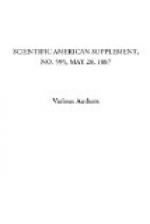I cannot, however, but think that it would be of the greatest service to botanists, physicists, and mineralogists alike, if some resident in India would resume the investigations so admirably commenced by Dr. Patrick Russell nearly a century ago; and it is in the hope of inducing some one to undertake this task that I have put together these notes. There are certain problems with regard to the mode of occurrence of this singular substance which could only be solved by an investigator in the country where it is found.
[Illustration: SECTION OF INDIAN TABASHEER, SEEN WITH A MAGNIFYING POWER OF 250 DIAMETERS.]
Most parcels of the commercial tabasheer appear to contain different varieties, from the white, opaque, chalk like forms through the translucent kinds to those that are perfectly transparent. It would be of much interest if the exact relation and modes of origin of these different varieties could be traced. It would also be important to determine if Brewster was right in his conclusion that the particular internodes of a bamboo which contain tabasheer always have their inner lining tissue rent or injured. The repetition of Dr. Russell’s experiment of drawing off the liquids from the joints of bamboos and allowing them to evaporate is also greatly to be desired. My colleague, Prof. Rucker, F.R.S., has kindly undertaken to re-examine the results arrived at by Brewster in the light of more recent physical investigations, and I doubt not that some of the curious problems suggested by this very remarkable substance may ere long find a solution.
JOHN W. JUDD.
* * * * *
THE EDIBLE EARTH OF JAVA.
In 1883 Mr. Hekmeyer, pharmaceutist in chief of the Dutch Indies, exhibited at Amsterdam some specimens of Javanese edible earth, both in a natural state and in the form of various natural objects. A portion of this collection he has placed at our disposal, and has given us some information regarding its nature, use, etc.
These clays, which are eaten not only in Java, but also in Sumatra, New Caledonia, Siberia, Guiana, Terra del Fuego, etc., are essentially composed of silex, alumina, and water in variable proportions, and are colored with various metallic oxides. They are in amorphous masses, are unctuous to the touch, stick to the tongue, and form a fine, smooth paste with water. The natives of Java and Sumatra prepare them in a peculiar way. They free them of foreign substances, spread them out in thin sheets, which they cut into small pieces and parch in an iron saucepan over a coal fire.
Each of these little cakes, when shrunken up into a little roll, looks somewhat like a grayish or reddish fragment of cinnamon bark. The clay is also formed into imitations of various objects.
We have tasted this Javanese dainty, and we must very humbly confess that we have found nothing attractive in the earthy and slightly empyreumatic taste of this singular food. However, a sweet and slightly aromatic taste that follows the first impression is an extenuating circumstance.




